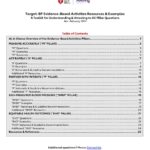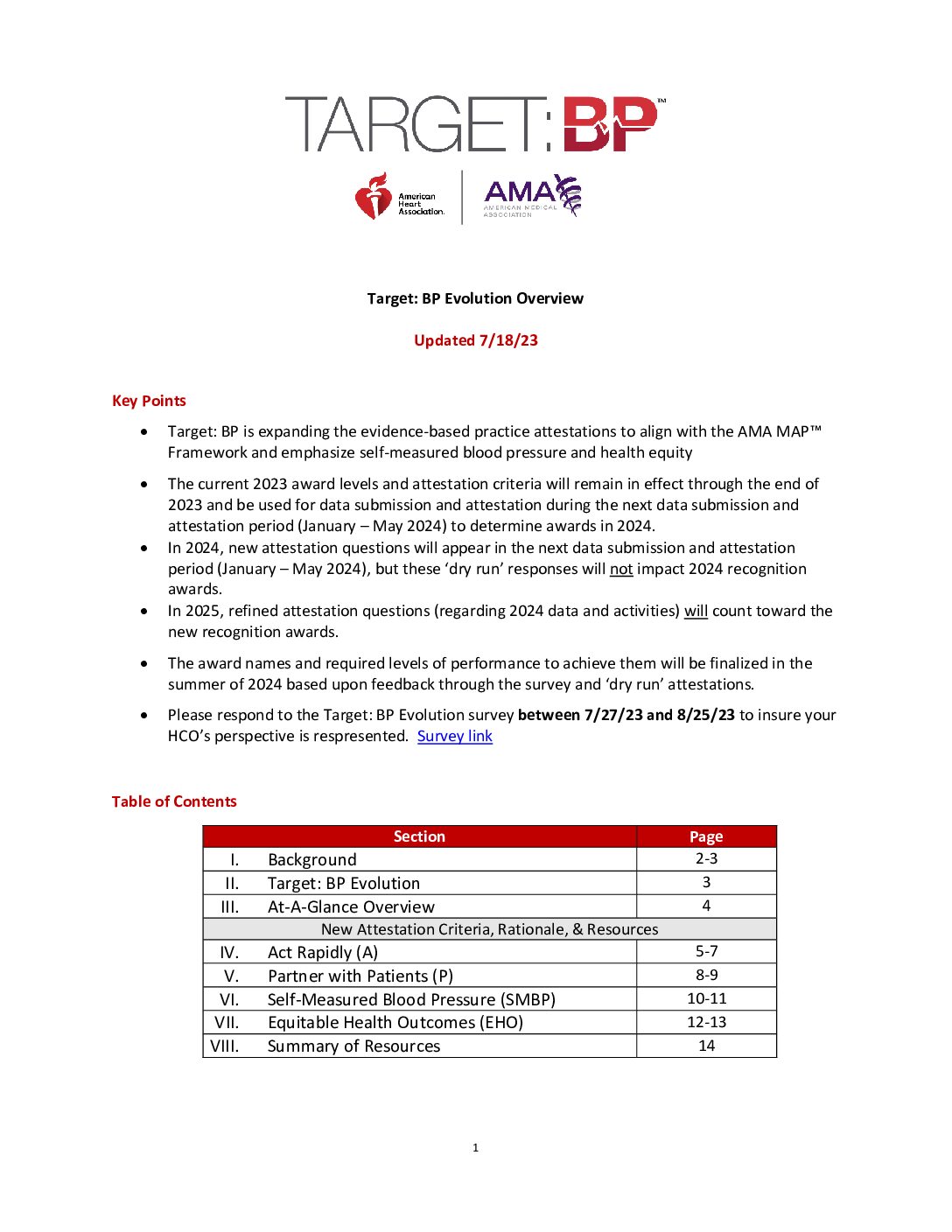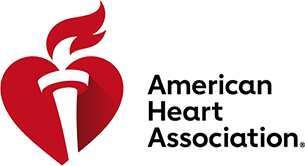In addition to encouraging health care organizations to improve patient outcomes by measuring blood pressure control rates, Target: BP also encourages organizations to strengthen care processes by adopting evidence-based activities.
Each pillar contains:
- An element of institutional policy or a defined standard of care
- An element of practice assessment compared to the standard
- Specific content associated with strong scientific evidence to improve BP control
Each element is a recommended practice. When submitting data annually for recognition, refer to the Overview to see how specific attestations can contribute to annual award level.
BP measurement is the first step in accurately diagnosing and managing hypertension as well as estimating CVD risk. Device accuracy, measurement knowledge and skills, and systems of care are essential evidence-based BP activities.
Calibrate devices per guideline
Check device validation
Train team in BP measurement
Test team in BP measurement
Adopt protocol for repeat measurement
Post infographic where BP is measured
I attest that my organization:
- Calibrates all BP measurement devices per manufacturer recommendation including manual aneroid or oscillometric, semi-automated, or fully automated devices.
- If using semi/fully automated devices, check the US Blood Pressure Validated Device Listing (VDL™) or other reliable source to see if they are validated for clinical accuracy. Report the percent of devices that are currently validated.
- Strengthens BP measurement knowledge every 6-12 months for all staff who measure blood pressure or train staff to measure blood pressure using Achieving Accuracy BP Measurement e-learning module, OR Measuring Blood Pressure Accurately – Step 1 in Hypertension Control (free webinar), OR another structured curriculum.
- Tests staff’s BP measurement skills every 6-12 months (using the Technique Quick Check Tool OR similar objective assessment).
- Uses a blood pressure measurement protocol to consistently obtain accurate BP measurements, including confirmatory repeat in-office BP measurements – OR – ambulatory blood pressure monitoring – OR – home blood pressure monitoring with self-measured blood pressure when indicated.
- Posts a positioning graphic, such as the In-Office Measuring Blood Pressure Infographic, next to every place where blood pressures are taken.
Resources:
- 2019 AHA Scientific Statement on BP Measurement in Humans
- Target: BP Measure Accurately Quick Start Guide
- US Blood Pressure Validated Device Listing (VDL™) at validatebp.org
- Achieving Accuracy BP Measurement e-learning module, OR Measuring Blood Pressure Accurately – Step 1 in Hypertension Control
- Technique Quick Check Tool
- Blood Pressure Measurement Policy & Procedure Template
- Post the In-Office Measuring Blood Pressure Infographic
The Act Rapidly evidence-based activities emphasize the adoption and systematic use of a practice-wide hypertension treatment protocol that includes elements related to treatment goals, medication intensification, medication adherence strategies, and timely follow-up.
Adopt a treatment algorithm
Monitor care team adherence to algorithm
Specify a treatment goal of <130 / 80 mm Hg*
*for adults with confirmed hypertension and known CVD or 10-year ASCVD event risk of 10% or higher
Intensify treatment if not at goal
Use single pill combos or other Rx adherence strategies
Follow-up within 1 month if not at goal
I attest that my organization uses a practice-wide1 hypertension treatment protocol that includes (at a minimum):
- Formal approval and systematic2 implementation into clinical practice
- Monitoring3 to assess the use of the protocol in practice
- A blood pressure control treatment goal of <130 /80 mm Hg for adults with confirmed hypertension and known CVD or 10-year ASCVD event risk of 10% or higher
- Prompts for clinicians/prescribers to intensify treatment with additional medication classes or increased doses for patients with/who have uncontrolled hypertension
- Strategies designed to improve patient adherence such as once-daily dosing and single-pill combinations when appropriate
- Follow-up contact within a 1-month period for patients with Stage 1- 2 hypertension who have not yet reached their hypertension treatment goal
- The intent of ”practice-wide” protocol means that the protocol (or algorithm) has been formally adopted, is systematically available across care settings where the patient population being reported in your control rate is receiving care, which could be, for example, an individual clinic site or an entire health system.
- “Systematic implementation” could be through integration into the EMR, a paper-based record or tool, or other means that provide consistent access to the standard of care for every patient
- “Monitored/Monitoring” can be achieved through means such as but not limited to manual chart review sampling or analysis of EMR or population health data, at least annually to assess if the policy/protocol is being followed. This requirement does not specify a level of adherence to the policy/protocol.
Resources
- Use the Target: BP Act Rapidly Quick Start Guide
- AMA Hypertension Medication Treatment Protocol
- 2022 Medication Adherence and Blood Pressure Control – A Scientific Statement from the American Heart Association
- Educate patients on single-pill combination therapy and knowing your numbers with resources from the National Association of Community Health Centers: Simplify-Your-Pill-Routine-Postcard, Simplify-Your-Pill-Routine-Poster (from the National Association of Community Health Centers)
The Partner with Patients pillar emphasizes systematic lifestyle risk factor assessment and intervention.
Adopt a modifiable lifestyle risk factor policy
Monitor care team adherence to policy
Assess modifiable lifestyle risk factors
– nutrition, physical activity, weight
Intervene with modifiable lifestyle risk factors
– nutrition, physical activity, weight
Assess modifiable lifestyle risk factors
– alcohol and tobacco use
Intervene with modifiable lifestyle risk factors
– alcohol and tobacco use
I attest that my organization provides risk-factor assessment and non-pharmacological interventions for patients with hypertension to support positive lifestyle changes that includes a systematic2:
- Policy and/or procedure for the assessment of risk-factors and use of non-pharmacological interventions
- Monitoring3 to assess the use of the policy in practice
- Assessment of nutrition, sodium, and potassium intake, physical activity, weight, and body mass index or other indicators of obesity
- Intervention4 to improve nutrition, reduce sodium intake, increase dietary potassium intake, increase physical activity, and reduce weight as indicated
- Assessment of alcohol consumption and tobacco
- Intervention to address alcohol moderation/cessation and tobacco cessation
- “Systematic implementation” could be through integration into the EMR, a paper-based record or tool, or other means that provide consistent access to the standard of care for every patient
- “Monitored/Monitoring” can be achieved through means such as but not limited to manual chart review sampling or analysis of EMR or population health data, at least annually to assess If the policy/protocol is being followed. This requirement does not specify a level of adherence to the policy/protocol.
- “Intervention” includes, but is not limited to education, counseling, and/or referral such as educational hand-outs, consultation with a Registered Dietitian, participation in an exercise or cooking class, use of physical activity and nutrition prescriptions, or referral to tobacco cessation program
Resources:
The SMBP pillar emphasizes training patients in measurement technique and evidence-based use of SMBP monitoring by clinicians to inform diagnosis and treatment.
Adopt a policy to prepare patients for SMBP
Monitor care team adherence to policy
Train patients in measurement technique and device use
Establish a measurement schedule
Receive and average readings to inform diagnosis and treatment decision
Use SMBP with 30 or 10% of patients with hypertension*
*whichever is larger
I attest that my organization utilizes self-measured blood pressure to confirm a diagnosis, guide treatment intensification, or support longer-term lifestyle change and/or medication adherence for hypertension. Our self-measured blood pressure program includes (at a minimum), systematic2:
- Policy and/or procedure defining the steps to prepare patients for SMBP monitoring
- Monitoring3 to assess the use of the policy in practice
- Assessment to ensure the appropriate BP cuff size for the patient and education to prepare patients to use SMBP including, at a minimum, measurement training to properly position and use the device
- Approach to establishing a measurement schedule, ideally two times in the morning and two times in the evening for 3-7 consecutive days
- Receipt of readings from the patient via any means5 and review and averaging of a minimum number of 12 SMBP readings from a month of home monitoring to help inform diagnostic and treatment decisions
- A minimum of 30 patients or 10% of our patient population with hypertension per year (which ever number is larger) utilize SMBP monitoring as described above
- “Systematic implementation” could be through integration into the EMR, a paper-based record or tool, or other means that provide consistent access to the standard of care for every patient
- “Monitored/Monitoring” can be achieved through means such as but not limited to manual chart review sampling or analysis of EMR or population health data, at least annually to assess If the policy/protocol is being followed. This requirement does not specify a level of adherence to the policy/protocol.
- “Means” including but not limited to return of paper recording logs, review of readings stored on the device, use of device app or remote patient monitoring (RPM) platform, or direct transmission into the electronic health record (EHR)
Resources:
The Equitable Health Outcomes pillar emphasizes the use of race and ethnicity (R/E), and social determinants of health (SDoH) data to stratify blood pressure control rates and to identify and address possible disparities.
Adopt a policy to gather R/E data
Adopt a policy to gather SDOH
Train care team to gather data per policy
Monitor care team adherence to policy(s)
Stratify BP control rate data by 2 sub-groups
Examine data for gaps and take action
I attest that my organization collects and uses patient population data to assess for equitable health care improvements and outcomes in blood pressure control that includes:
- Adoption of a policy and procedure to systematically gather race/ethnicity (R/E) data
- Adoption of a policy and procedure to systematically assess Social Determinants of Health (SDoH)
- Monitoring of team adherence to policy and procedure(s)
- Training our team to gather data per policy (s)
- Stratification6 of control rate data at least annually by 2 sub-groups at risk for inequitable health outcomes such as patients from racial or ethnic groups, without insurance, by zip code and/or by SDoH elements
- Examination and use of data for care / quality improvement opportunities and takes action to address gaps and outcomes across groups.
- “Stratification” includes but is not limited to examining control rates review by age, sex, gender identity, race, ethnicity, primary language, insurance status, zip code, or housing status.
Resources:
- Race & Ethnicity Data Collection Essentials
- Social Determinants of Risk and Outcomes for Cardiovascular Disease. A Scientific Statement From the American Heart Association
- Racial and Health Equity: Concrete STEPS for Smaller Practices: Translate Your Commitment to Racial and Health Equity Into Action in Your Practice
Science
The rationale for each new criterion is based on the 2017 AHA/ACC Guidelines for the Prevention, Detection, Evaluation, and Management of High Blood Pressure in Adults.
See the Target: BP Evidence-Based Activities Resources & Examples document for the full rationale and guideline recommendations.
-
Related Resources
 Evidence-Based Activities Resources & ExamplesThis toolkit focuses on the evidence-based BP activities and includes examples of what actions would satisfy the intent of the attestation criteria, rationale for including new activities, guideline recommendations, answers to FAQs, and resources to better understand and implement change in order to meet the attestation criteria.
Evidence-Based Activities Resources & ExamplesThis toolkit focuses on the evidence-based BP activities and includes examples of what actions would satisfy the intent of the attestation criteria, rationale for including new activities, guideline recommendations, answers to FAQs, and resources to better understand and implement change in order to meet the attestation criteria. Evidence-Based BP Activities Q&A WebinarThis recorded webinar covers the data submission essentials for Silver or Gold+ awards eligibility. Includes Q&A session with experts.
Evidence-Based BP Activities Q&A WebinarThis recorded webinar covers the data submission essentials for Silver or Gold+ awards eligibility. Includes Q&A session with experts. Target: BP Recognition Program Evolution OverviewThis document provides an overview of the new additional attestation criteria, rationale, and resources for achieving evidence-based practices.
Target: BP Recognition Program Evolution OverviewThis document provides an overview of the new additional attestation criteria, rationale, and resources for achieving evidence-based practices.

